

A Crossbow Mechanism with Some Unique Features
from Shandong, China
Text and Photographs © Stephen Selby, 2001
I have had an opportunity to examine and photograph a bronze crossbow mechanism from China. This article documents my findings.
Background of the Crossbow in China
Chinese literary records (Zhao Ye: 'The Romance of Wu and Yue') date and place of the invention of the crossbow in China to the Warring States period state of Chu (Selby: 'Chinese Archery'. Hong Kong University Press, 2000. p. 158), with the implication that the crossbow was unknown in China before about 500BCE. Most contemporary writers - for example Yang Hong (Yang Hong: ‘Collected Essays on Ancient Chinese Weapons’ (Zhongguo Gu Bingqi Luncong). Cultural Relics Press, Beijing, 1985) and Zhu Fenghan (Zhu Fenghan: ‘Ancient Chinese Bronzes’ (Gudai Zhongguo Qingtongqi). Nankai University Press, Tianjin, 1995) - doubt the historical account. Comparing
the construction and use of crossbows by China's modern national minorities,
bone, shell and stone items found in archaeological excavations that correspond to the trigger mechanisms of modern national minority crossbows, and
the possibility of interpreting some early Chinese characters as denoting the crossbow,
these authors are prepared tentatively to push the time of development of the crossbow in China to the eneolithic/chalcolithic period around 2000BCE.
Be that as it may, field archaeology has not yet uncovered bronze crossbow mechanisms dating earlier than the start of the Warring States period in around 600BCE (A grave burial at Qufu, the ancient capital of Lu. See Zhu Fenghan: ‘Ancient Chinese Bronzes’ p. 274). Since the ability to create high-precision bronze castings is clearly evident from as far back as the Shang period in around 1300BCE, this late development of the use of bronze for crossbow mechanisms is surprising. So also is the absence of an unambiguously-read Chinese character denoting the crossbow. (I discount here references to the crossbow in 'Tai Jia' section of the Shang Shu as a Han Dynasty fabrication.)
Alternative crossbow mechanisms
Surprising as it might seem, there is in fact no need for a simple crossbow to have any mechanical release device at all. The string can simply be snagged over a hollow at the end of the stock, and then released by upward pressure of the thumb (top diagram: I).
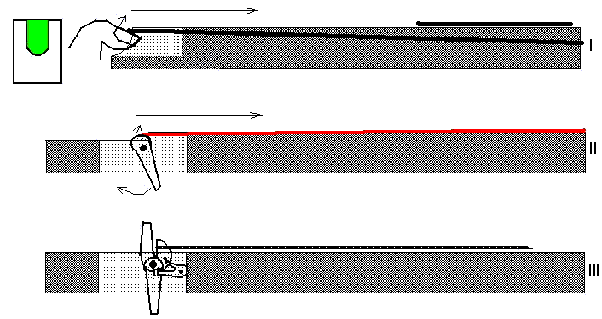
This first option avoids the need for moving parts; but it is difficult to release like this without jogging the stock. (It has to be said that although I consider this a viable design, I am not aware of it having been widely adopted.) A simple mechanical replacement for the thumb allows the backward movement of the trigger-finger to be translated by the trigger-lever into a rotating upward movement, forcing the string off a snag on the top of the stock (middle diagram: II).
This second method is employed today by China's south-western national minorities. They cock their crossbows and place a very light quarrel at the forward end of the stock, allowing the string to strike it at high speed and knock the quarrel forward. This has the disadvantage that the quarrel cannot be in contact with the string (let alone be nocked onto it) before release. A further disadvantage is that the crossbow stock has to be held motionless and at a relatively low angle before release. Although the method is unstable, tribesmen have been achieving accurate results for millennia using it.
The third method is to create a more complex, three-part mechanism whereby the string can be held on two teeth of a tumbler (with the quarrel nocked between the teeth of the tumbler) and be prevented from releasing by a sear held in place by the trigger (bottom diagram: III). This form is very stable. The stock can be held almost vertical, or moved around to follow a moving target, without much risk of the quarrel dropping off.
It is the only the third form in ancient China for which any unambiguous archaeological evidence has been discovered. In the Ming Dynasty, however, Mao Yuanyi (Mao Yuanyi: 'Wu Bei Zhi'. See Selby: 'Chinese Archery', p. 312) commented that crossbows of his time had mechanisms made from deer antler. This suggests that following the loss of skill in bronze technology during the Mongol Yuan Dynasty, simple one-part mechanisms had come back into use.
Bronze Crossbow Mechanisms in China
Once bronze crossbow mechanisms start to appear in the archaeological context from about 600BCE onward, findings are common. Moreover, literary records detailing the usage of the crossbow become frequent from about the same period, for example in the works of Sun Wu ('Sunzi') dating from around the fifth century BCE. There is prominent mention of the crossbow in military strategy during the fourth Century BCE (for example the Battle of Maling in 341BCE. See Selby: 'Chinese Archery', p. 170). By the Han Dynasty, in 206BCE, there is no doubt that the crossbow had become the military projectile weapon of choice among the Han Chinese, particularly for infantry engagements, and occasionally for cavalry engagements.
We can detect a chronological progression in the development of bronze crossbow technology involving one original form (I shall refer to it as 'type A'), succeeded by two evolved forms 'types B & C', one of which ('type B') did not survive beyond the Qin Dynasty (206BCE).
Type A mechanism (axles missing). Qin.Type A: a bronze mechanism with three working parts (tumbler, sear and trigger) and two passive axles, supported completely by the wooden stock of the crossbow.
Type B: a bronze mechanism with three working parts and two passive axles, supported by a bronze casing outside the wooden stock, drilled so that the axles are supported by the bronze casing.

Type C: a bronze mechanism with three working parts and two passive axles, supported within a bronze casing sunk completely into a hollowed section of the wooden stock.
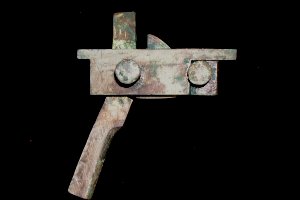
Type A exhibits a clear disadvantage in that only the outer ends of the two axles are in contact with the stock. This means that the surface area over which the string’s tension on the tumbler is transmitted to the stock is very small. Typically, the axles have a diameter of 0.75cm, the forward half of which transmits the tension of the string to the stock, with about 0.75cm seated in a hole drilled on each side of a trough gouged in the stock. Only the forward axle bears the load of the string (through the tumbler), while the rear axle simply permits the sear to drop. The whole surface area transmitting the string tension to the stock therefore might not be more than 1.8 cm². (Two forward-facing surface segments (i.e. half), each 0.75cm long, of a cylinder of 0.75cm Ø:
π * 0.375 * 0.75 * 2 = 1.767cm². Being a cylinder, the pressure would not be transmitted evenly over the whole surface area, either.) A heavier draw-weight would easily put more strain on the wood than it could take, especially as it would tend to split the grain.Type B
attempts to overcome this problem by seating the ends of the axles in a hard bronze casing fitting over the outside of the stock adjacent to the lock. The surface area of contact is much smaller, but the material is strong enough to withstand a higher string tension.Type C contains the whole of the mechanism in a bronze housing within the stock. It generally provides the advantages of type B. But in type C, the bronze housing is compact and no moving parts are in contact with surrounding wood. The load-bearing surfaces of contact are maximized. The elements were also probably heavily-greased and highly resistant to moisture.
This article examines an example of the type B mechanism.
A Type B Mechanism from Shandong, China
The crossbow mechanism under discussion was found in Zibo, Shandong province. It is in a good state of preservation, with light patination. Within the rear of the mechanism is a piece of the original wood from the stock. The wood has not shrunk or deformed, suggesting that the whole assembly had largely remained dry throughout the time it has been interred. The whole assembly consists of the mechanism itself in its bronze casing, a bronze trigger-guard, two bronze spikes and two bronze arrowheads with iron tangs. The iron tangs have almost completely corroded, and corroded iron has become attached to various parts of the other surrounding bronze items.
Inner parts of the mechanism. A: tumbler, B: sear, C:
trigger, D1,2: axles, E: bronze catch.
The tumbler (A) comprises two side elements connected by a bar, all cast in one piece and filed or ground into shape, with the hole either drilled or cast and finished. One side element extends upward and the top of the extension is decorated with a dragon's head. (This feature variously served as a counter-weight, to catch the string as it was drawn back to cock the crossbow, as well as an aid to aiming. As far as I know, these mechanisms were not counter-sprung.) No other decoration or writing are discernable on the tumbler. Compared to other bronze tumblers I have examined, the design is more angular.
|
|
|
The sear (B) is cast in one piece with the hole drilled through it or cast and finished. Again, the design is chunky and angular compared to other bronze sears I have examined. Careful examination revealed a single mark (possibly a Chinese character) within the jaw of the sear.
|
|
|
The trigger (C) is cast in one piece with the hole drilled or cast and finished. It has a distinctive, dog-leg design. The front face of the trigger (left in the illustration, above the 'knee') shows clear signs of repeated impact against the bar of the tumbler. I take this as evidence that the mechanism has been repeatedly fired before burial. This, then, is a used, working weapon: not a ritual item for burial.
The axles (D1,2) are each 0.7cm in diameter. The left one (D1: 3.3cm) is the sear axle. It has flattening in two places on one face, preventing it from revolving in the housing. The the right one (D2: 3.5cm) is the tumbler/trigger axle and has no flattening.
The bronze catch (E) comprises a bronze tube, 1.2cm in diameter at one end and 1.3cm in diameter at the other. The wall of the narrower end is slightly thicker. The tube seems to have been hammered into shape. A bronze stanchion stands out 1.5 cm from the wider end. Its purpose is discussed below.
Bronze casing viewed from the front
The bronze outer casing appears to have been cast in one piece. The channel at the top (left side in the picture) has no profile for the nock and fletching (such as is sometimes found on the tops of similar bronze casings), and there is evidence that a fillet of wood was stuck to it. The whole assembly is hollow. The handle is very short and evidently could not have accommodated the users whole palm. At the bottom (right side), a aperture is left into which the rear of the bronze trigger guard fits.
There is no decoration of any sort on the casing; but the rear is elegantly profiled and fluted. The forward-facing part of the handle is flattened. At the top of the handle is a space into which the trigger will recess snugly when pulled back.
Within the bronze casing, there remains a block of wood corresponding to the rear end of the stock. The species of the wood is unknown.
Rear end of the wooden stock.

Trigger guard
The trigger guard is an unadorned bronze band approximately 7cm in length, bent upwards at the front, with a lug projecting a further 2.8cm at the front, incurved at the extremity. The rear end has a lug 0.6cm long that fits snugly into the bottom-front of the handle. The front of the main part of the guard is is 2.5cm wide and the rear is 3cm wide. The thickness is 3mm throughout.
The overall assembly of the lock and casing is illustrated below -
Crossbow lock assembly with casing and trigger guard
The whole assembly allows us to discern the purpose of the bronze tube 'E'. It fits loosely over the trigger, but tightly if it is pulled up to the knee. Thus the protruding part, if rotated toward the back, prevents the trigger from being pulled, as the following images illustrate.
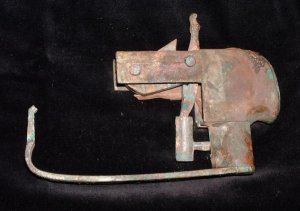 cocked and locked |
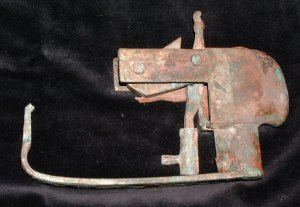 cocked and unlocked |
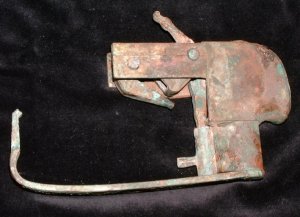 released |
As far as I know, this safety locking feature has not been found on a Chinese crossbow before.
The lock assembly apart, a pair of bronze spikes were found together with the lock. In terms of style, construction, material and preservation, they are consistent with being part of the crossbow.
Bronze spikes
There is no fitting to hold these spikes at the rear of the stock, so they probably belonged at the front. I have previously examined a Warring States wooden crossbow with vertical wooden posts of unequal length at the front of the stock. In fact, the lower extremities with the up-turned base show signs of contact with wood. The narrow channel running along the top of the left-hand (taller) spike is matched on its obverse side. There is no similar feature on the right-hand spike. The flanges on both spikes are on one side only.
Obverse of the left-hand spike showing channel with adhering wood
It is hard to speculate what this object did for the crossbow. If it was located at the front of the stock facing forward it would have been in a vulnerable position. Could the channels on both sides of the taller spike have accepted a hollow tube of bamboo split along one side to clip over the channels to form a sight? This would have been a delicate device to place in such a vulnerable spot; but it would not have been hard to replace of lost or broken. As to the other spike, I have no suggestion
Bronze/iron arrowheads 3.3cm
The two bronze arrowheads accompanying the crossbow have a triangular cross-section. They are typical of crossbow bolts of the period. The corrosion on the left-hand point bears the impression left by a cylinder of about 3.5mm diameter. This might have been the shaft of another bolt.
Overall assessment
The dog-leg design of the trigger of this mechanism is very close to that of one of the triggers excavated from the ancient Lu capital at Qufu, Shandong (Yang Hong: ‘Collected Essays on Ancient Chinese Weapons’, page 206, Ill. 126.) That excavation was dated to the early Warring States period, around 600 - 500 BCE. I would judge the design of this crossbow to be in the same tradition, although perhaps slightly later, as the Qufu lock had no bronze casing.
The skill in the construction of this weapon is in the utilitarian detail rather than in decoration. Indeed, other than the dragon-head sighting bead on the tumbler and the fluting on the case, there is no decoration at all. I would reconstruct the crossbow as follows:
Reconstruction of the crossbow
The specimen I have described adds something to our knowledge of early Chinese crossbows. The tactics at the Battle of Maling involved an ambush at night with crossbows. The literary record (Sima Qian: 'Historical Records' (Shi Ji), 'Biography of Sunzi and Wu Qi') mentioned specifically that marksmen were selected for the ambush, and that the troops were to wait (presumably in silence and with crossbows cocked.) We can see the value of the safety catch in such a situation, and this specimen clearly demonstrates that this was an issue specifically considered in the design.
The Qin kingdom of the Warring States period was to the west of Lu. At least until the demise of Qin Shi Huangdi, the first Qin Emperor, Qin stayed with the more primitive design lacking a bronze casing. (See various reports of the excavations of the Terracotta Warriors at Qinling.) The crossbows of Qin would have been inferior weapons. Given the Qin's preoccupation with military affairs, this is surprising.
I have not examined any other early crossbow mechanism in which the aiming element on the tumbler was anything more than utilitarian (barring some patterning with chased sliver or gold). By the Tang Dynasty, it had become fashionable to shape the rear sight in the form of a lion or even a kneeling man. However, a dragon head is something I have not see described before.
Last up-dated February 16, 2001